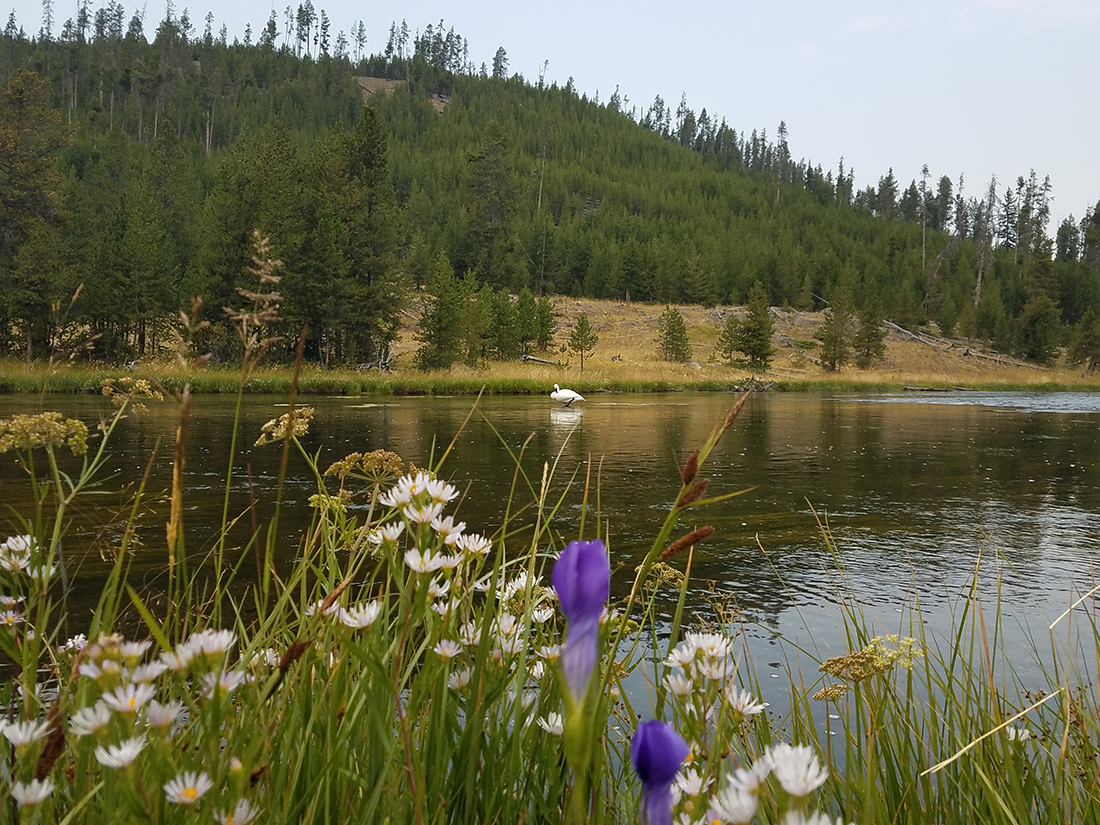
When you think of Yellowstone, you undoubtedly think of buffaloes, bears, and Old Faithful. Sure, there are buffalo- herds of bison occasionally block the road. But there are also elk, big horn sheep, antelope and more. Old Faithful erupts like clockwork, but it’s only one of an estimated 10,000 geysers in the park. Added to that are bubbling cauldrons of boiling, multi-hued pools of acidic water, oozing mud volcanoes, and caves that huff steam. There’s a canyon full of waterfalls, sweeping mountain views, a gorgeous old hotel overlooking a picturesque lake, and and and… There is so much more to it that even if you spent a week there you’d likely be itching to get back. You probably didn’t see a grizzly (and you’d only want to see them from afar), only a few folks spot a wolf, and only a tiny fraction get off the well-worn paths.
But those paths are often crowded for good reason. There is so much to see within a few steps of the road that Yellowstone is one of the most easily accessible – yet still stunning – places I’ve been. Within minutes of our arrival, we’d seen a swan, a few bison, and uncountable geothermal features. There are 3,471 square miles inside Yellowstone, and other parks border it, so there is more to see than you’ll have time for.
That’s okay. What you’ll see will impress you.
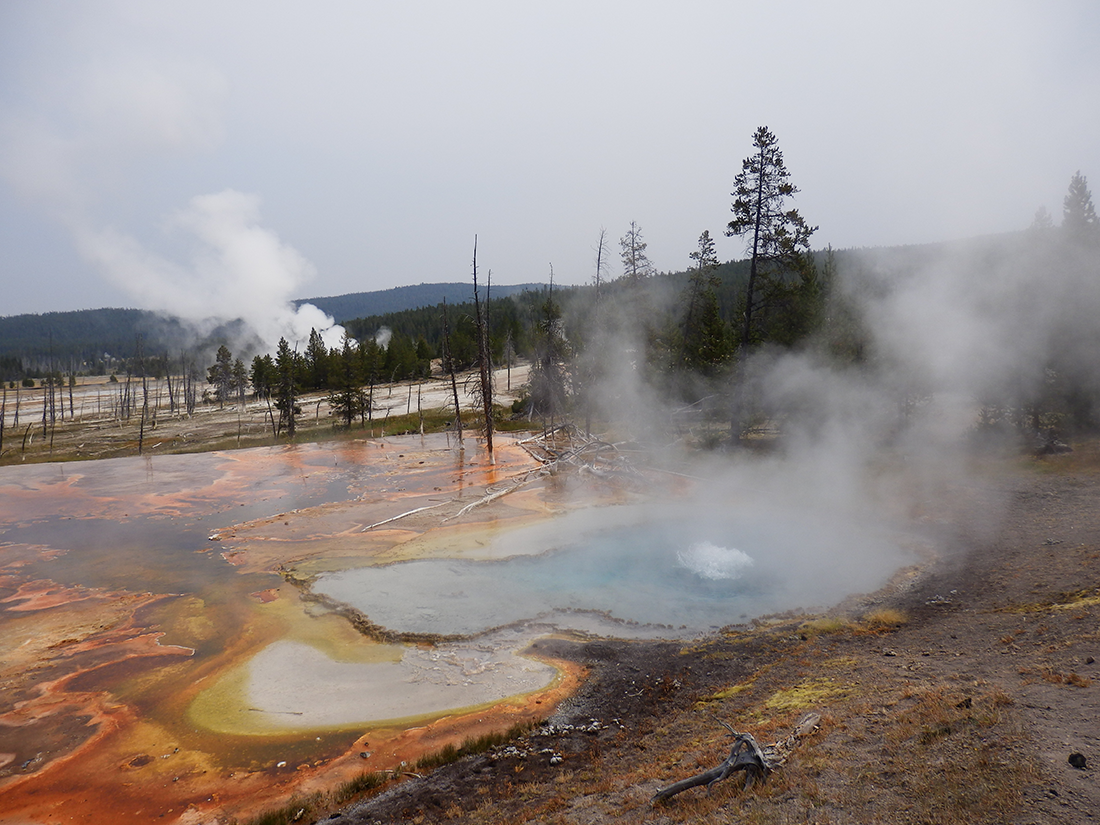
We stopped by the Lake Lodge, a gorgeous old hotel that I managed to get no pictures of because I was distracted by the row of 1920s cars that pulled in behind us, part a car club that was doing a tour of the park. I mention the hotel only because you should stop by and gawk if you’re in the neighborhood. The lobby has some beautiful details, and a nice gift shop.
Next on our tour, a series of geysers, bubbling pools of mud, and a cave at which you can clearly hear a dragon breathing (apologies for the external link, I didn’t get a great video myself.) Waves roll out as the creature inside shifts, the steam from his breath pouring out of the mouth of the cave. A neighboring pool of mud bubbles from several jets underwater, known as the Mud Volcano because it used to erupt and splatter mud into the treetops. Like a lot of features in Yellowstone, it has changed is behavior over the years. Even Old Faithful isn’t as faithful as it used to be. Some geysers go dormant, leaving huge mineral chimneys behind. New ones arise, sometimes melting the roads from below. You’re never far from a reminder that you’re standing on the floor of a dormant super-volcano that may destroy us all one day.
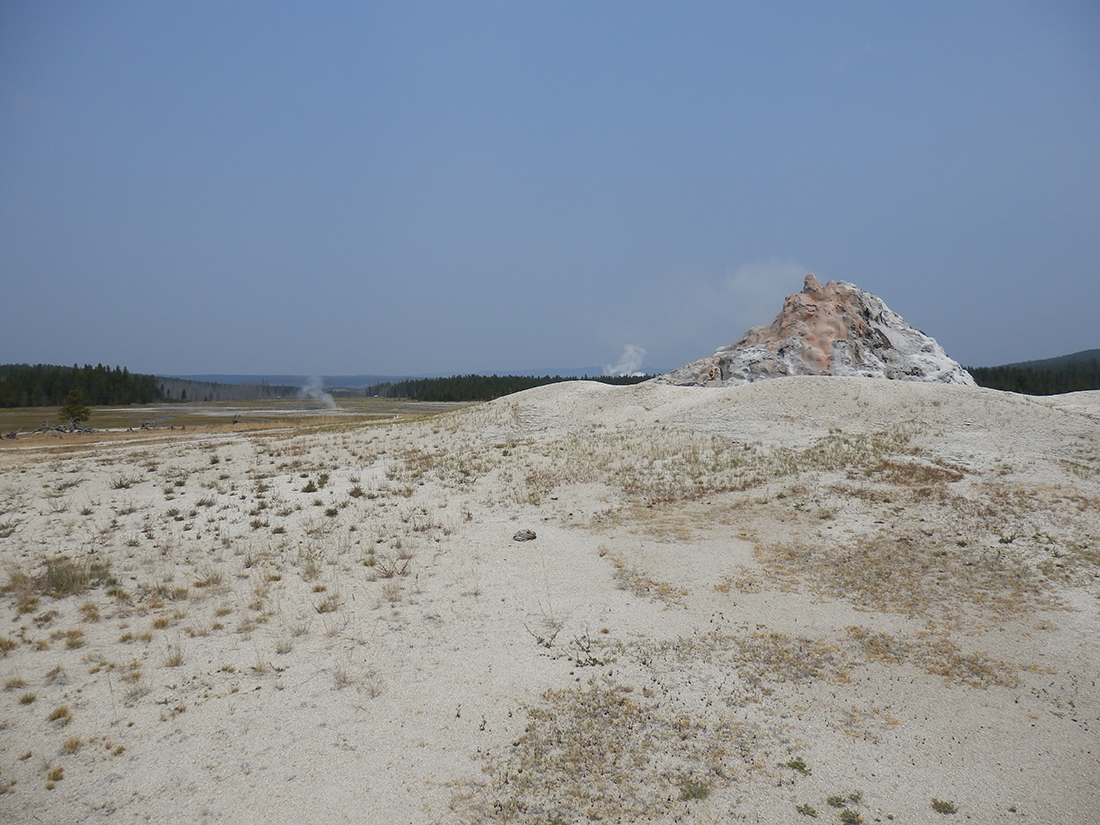
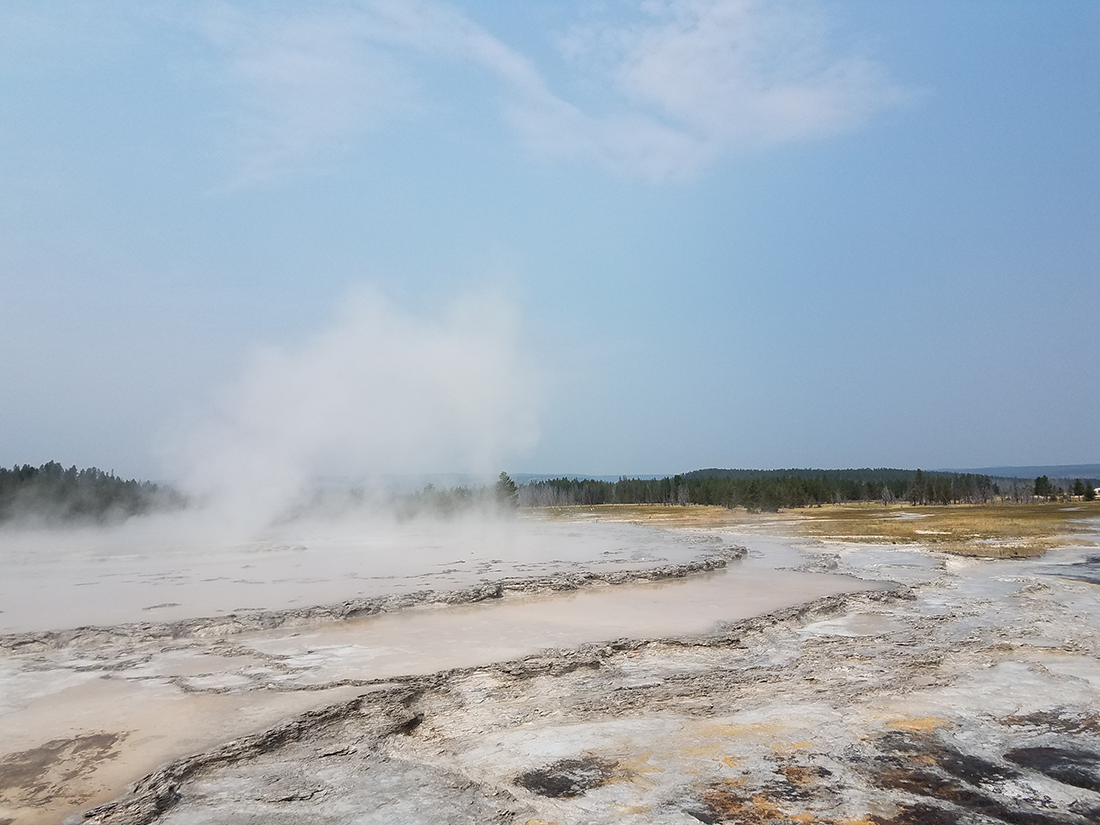
As often happens in Yellowstone, we had to stop for a rubbernecking traffic jam due to something to see just off the road, in this case a handful of bison. One of them was rolling about in the dirt, giving himself a bath as a flock of Canada geese watched. Just after we got moving, we stopped again, this time for a bison walking down the side of the road, only a few feet from passing cars.
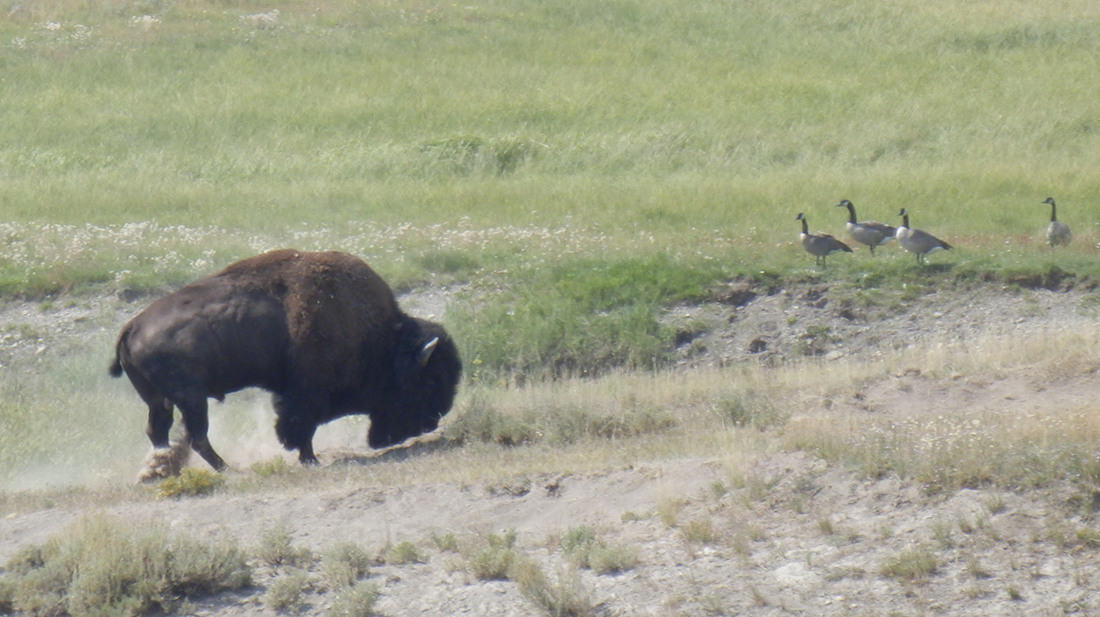
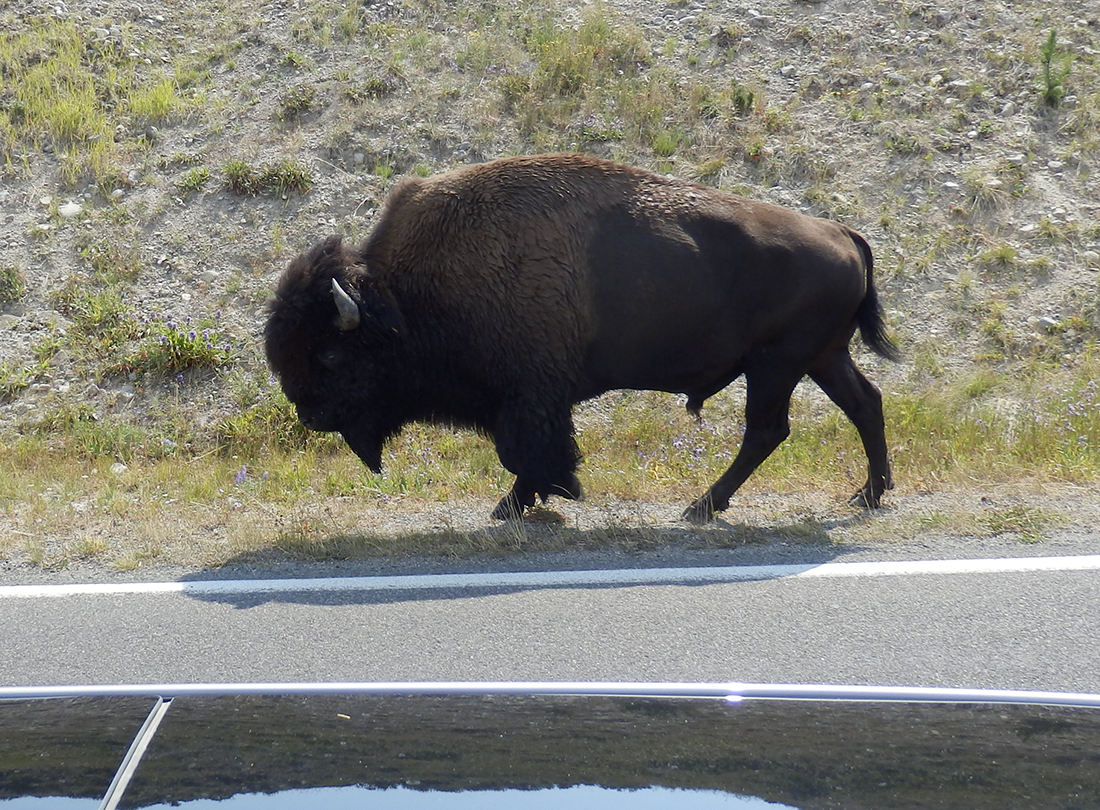
We stayed at the Canyon Village, conveniently located near the center of the park so you can get to all corners within a day’s round trip (it’s not so much the miles as it is the speed of traffic in many places.) There’s a food court with a small variety of restaurants (the fanciest of which requires reservations), a general store with an impressive selection of beer and wine, a post office, visitor’s center, laundromat and campground, all within a couple of blocks. We dropped our bags and used Google Maps to locate a nearby hike, only to find the trail was overgrown and hard to follow. Unbeknownst to us, it had been closed (there were no signs where we entered) so we were taken by surprise when we reached the edge of a massive gorge, the Grand Canyon of Yellowstone.
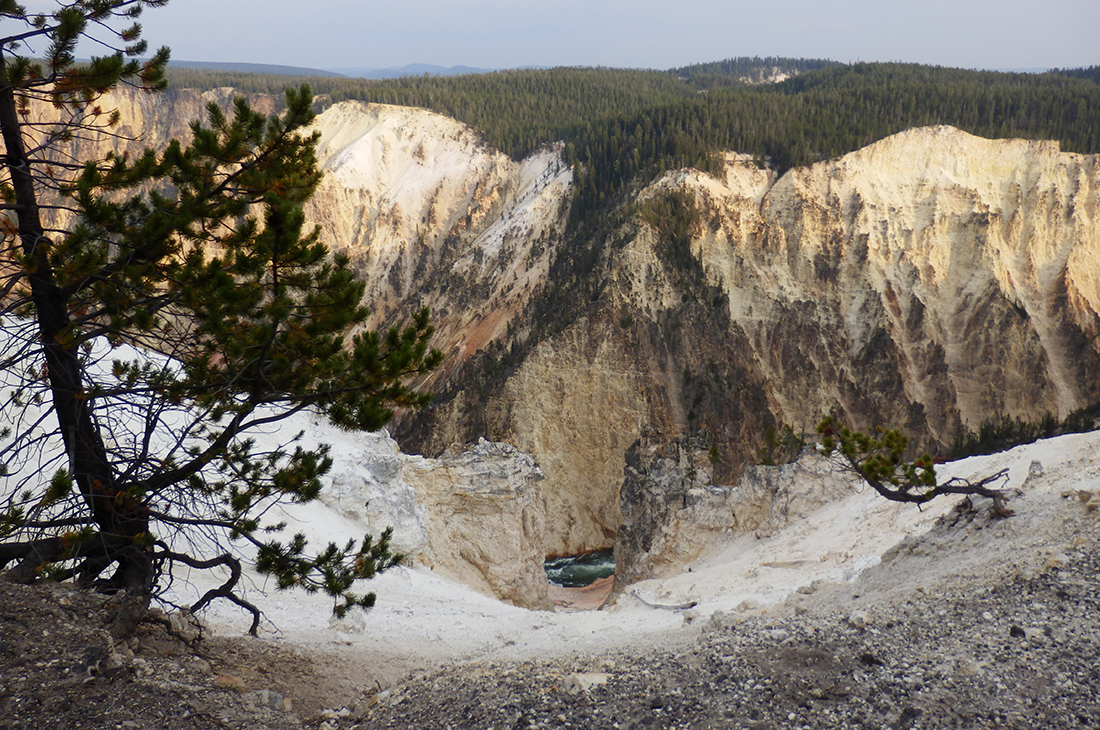
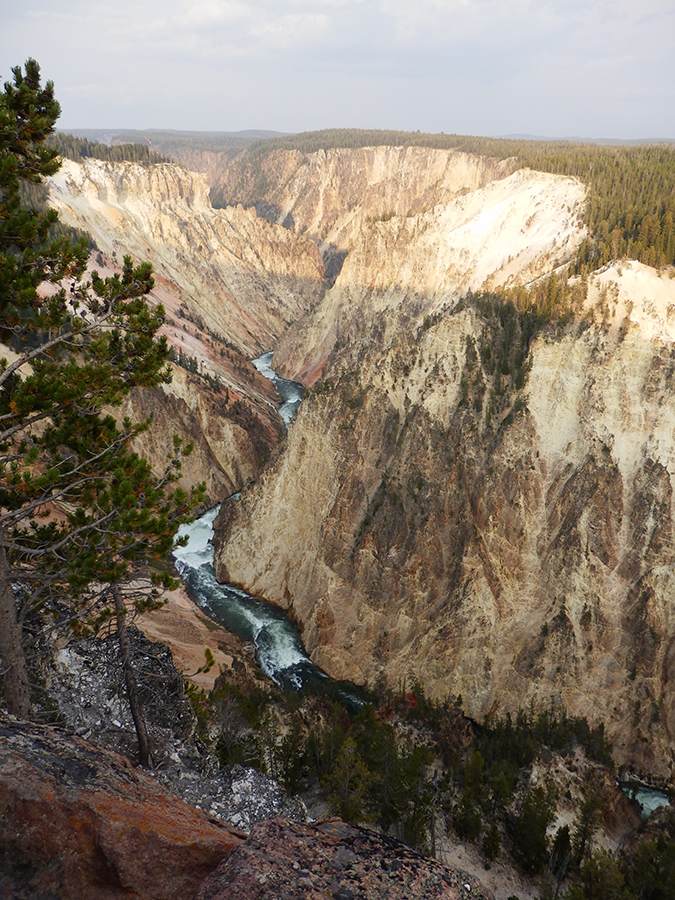 “Oh. Wow. It didn’t look nearly this impressive in the photos,” I muttered. Mixed in with the gray and beige palette were stripes of orange and green, above a stream of liquid coke bottle glass. Looking at my own photos now, I can see why I wasn’t anxiously looking forward to this particular attraction. I tried a few panorama shots but even those didn’t do the view justice. You don’t get a real sense of scale unless you’re standing on the edge.
“Oh. Wow. It didn’t look nearly this impressive in the photos,” I muttered. Mixed in with the gray and beige palette were stripes of orange and green, above a stream of liquid coke bottle glass. Looking at my own photos now, I can see why I wasn’t anxiously looking forward to this particular attraction. I tried a few panorama shots but even those didn’t do the view justice. You don’t get a real sense of scale unless you’re standing on the edge.
There were several places where the trail had crumbled down into the gorge, illustrating the reasons we hadn’t encountered anyone along the path. We reached a fence and the back side of signs informing us we weren’t supposed to be there and slipped around to spy our destination – the unimaginatively titled “Lower Yellowstone Falls” (could no one think of better names for sights in this place?)
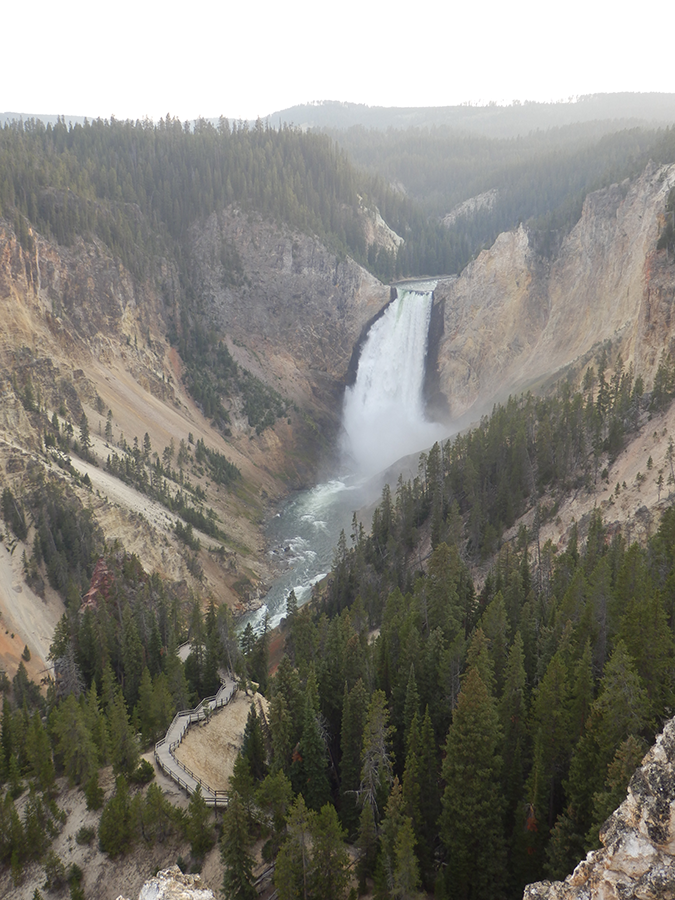
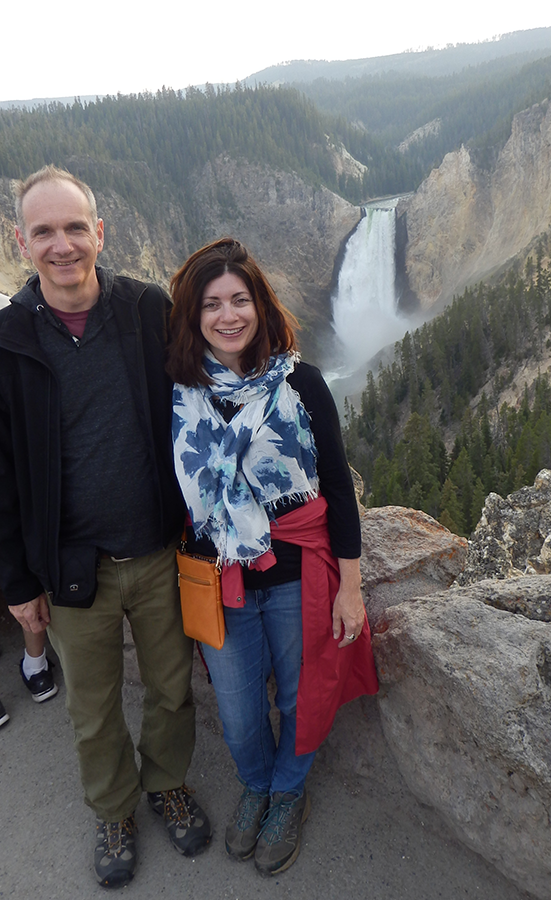 Stumbling upon it this way was one of the highlights of the trip. Other people had driven to the parking lot on the edge of the canyon and walked a few yards to an overlook – easier, to be sure, but our trek through the woods gave us varied views and a small sense of anticipation and discovery. We followed a path down to a pinnacle of red rock for a slightly closer look at the falls. There was another path upstream that lead down to the top edge of the falls (photo below, just to give you a better sense of the scale – those people are at the top right of the falls) but we’d had a long day and didn’t have the legs for it.
Stumbling upon it this way was one of the highlights of the trip. Other people had driven to the parking lot on the edge of the canyon and walked a few yards to an overlook – easier, to be sure, but our trek through the woods gave us varied views and a small sense of anticipation and discovery. We followed a path down to a pinnacle of red rock for a slightly closer look at the falls. There was another path upstream that lead down to the top edge of the falls (photo below, just to give you a better sense of the scale – those people are at the top right of the falls) but we’d had a long day and didn’t have the legs for it.
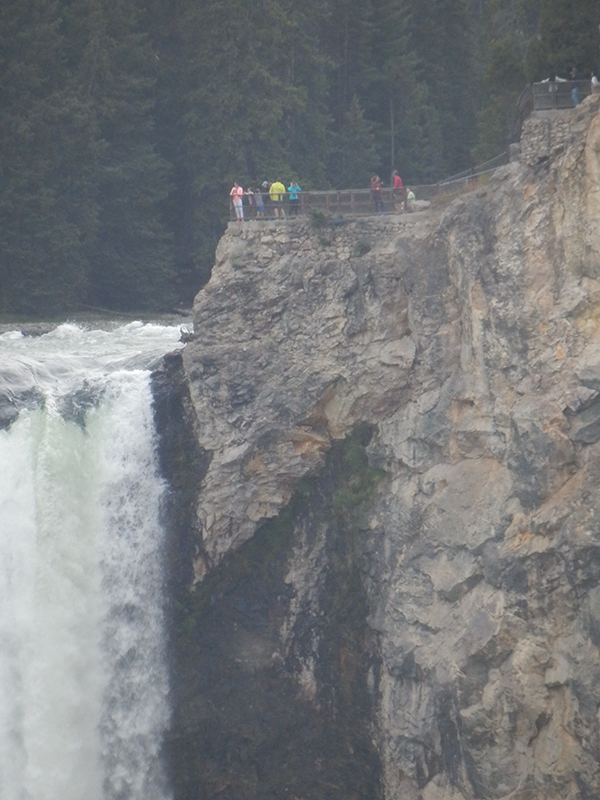
Instead, we hiked back to the hotel and jumped in the car to check out the other side of the canyon, a view called Artist’s Overlook or something like that, just as the sun set.
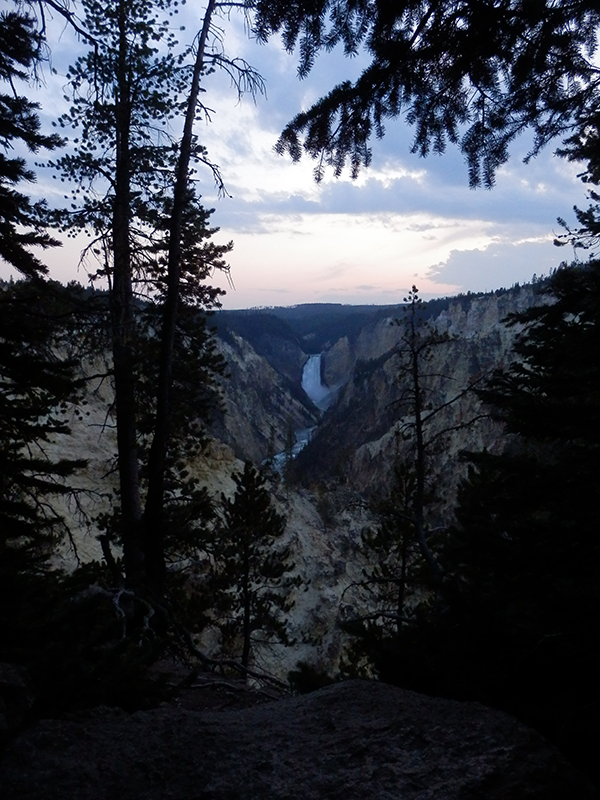
We rose early to try to beat some of the crowds and heat for a hike up Mount Washburn, one of the highest points in the park offering sweeping views of the surrounding valleys. It’s a long, uphill battle to reach the summit but along the way – at least in summer – you’re treated to near-endless wildflowers, changing type as you climb. The view eggs you on as well, getting progressively broader.
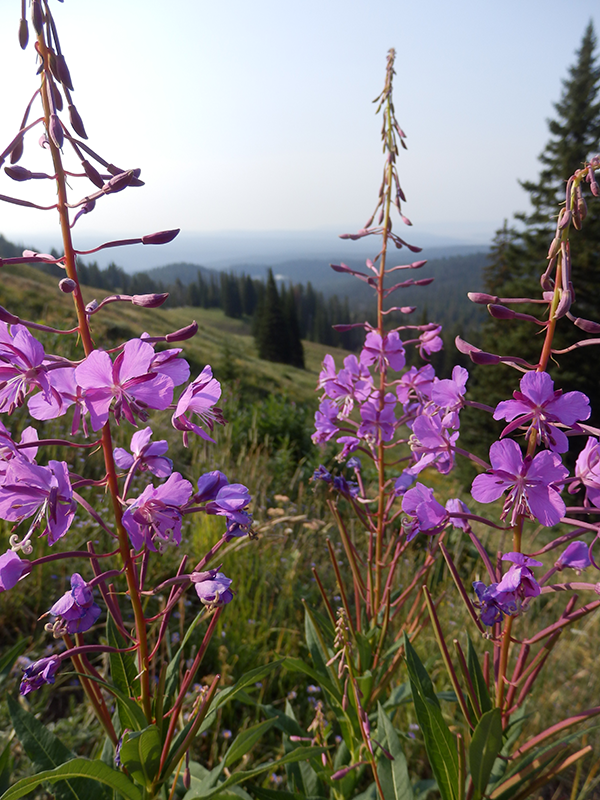
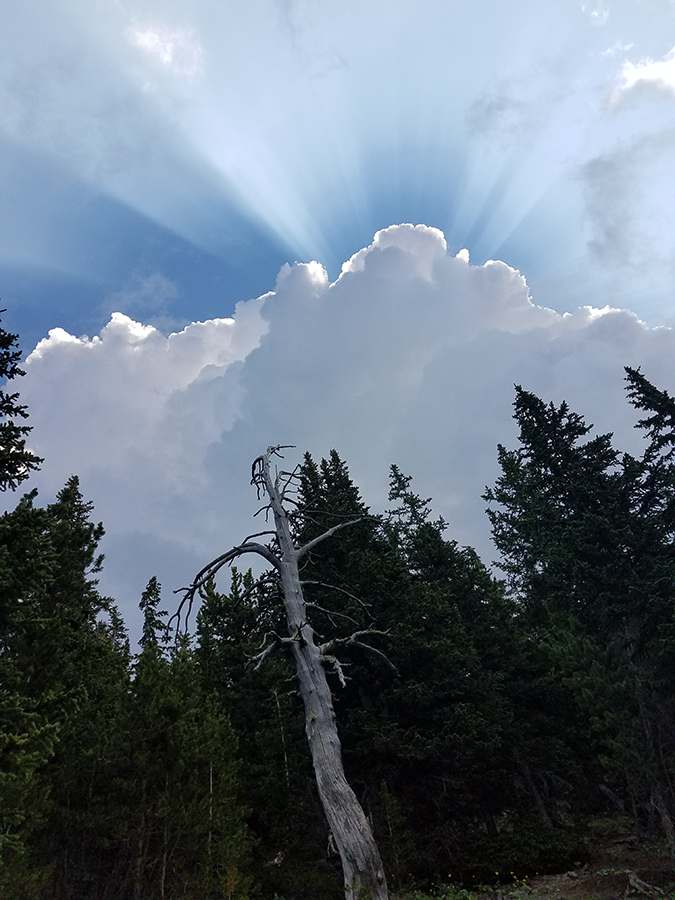
Just before we reached the summit, a young bighorn sheep walked across the hill to lick at the last vestiges of a melting snow pack, as if stopping by for some iced cream.
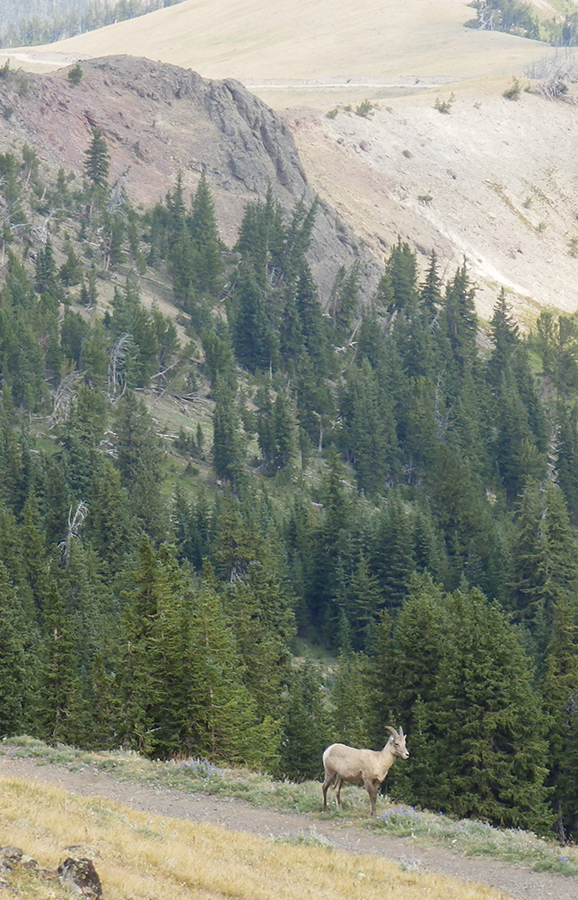
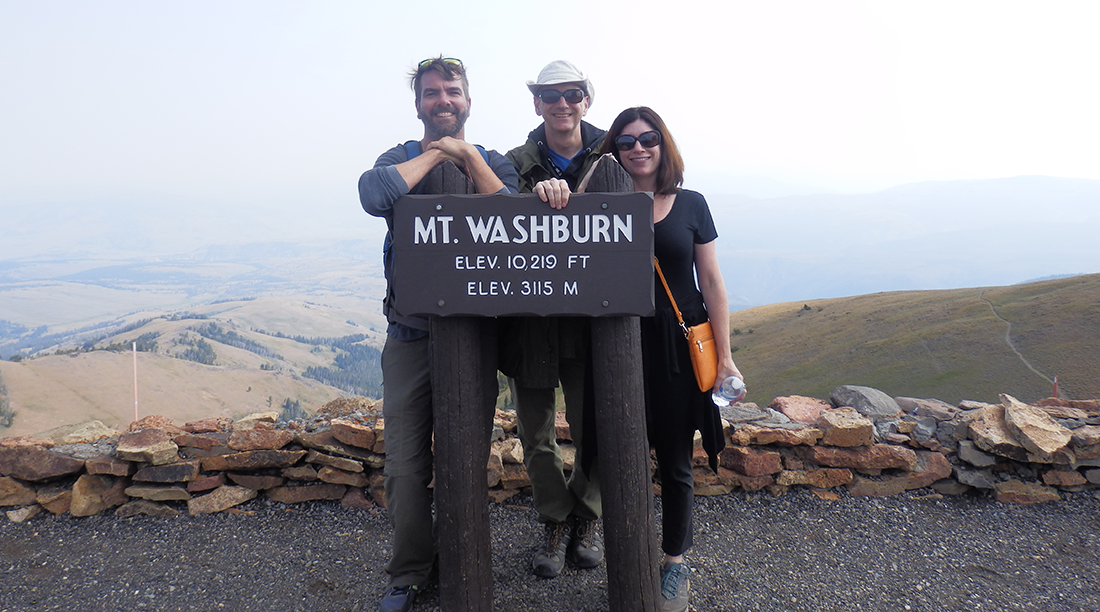
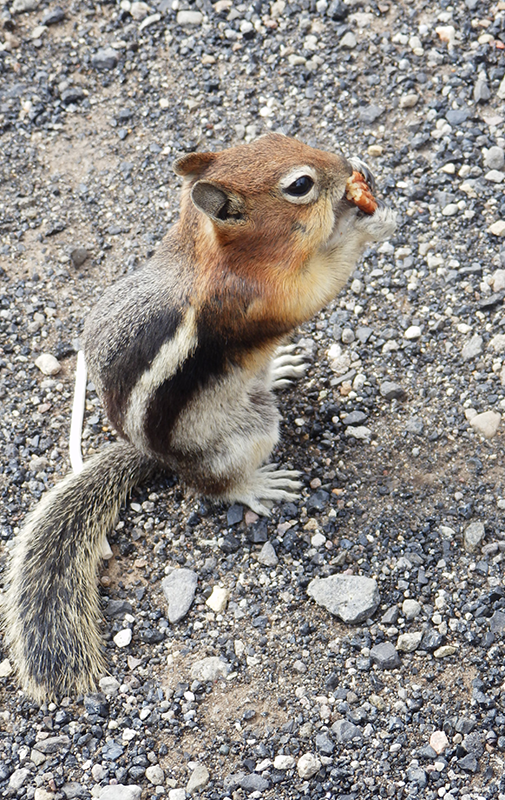 At the summit is a fire lookout station provides a viewing platform. Our view (click the link, then zoom in and scroll) was dulled by the smoke that had blanketed a lot of the northwest US. The canyon in the distance was difficult to make out and anything beyond was almost invisible. Apparently, that’s stark contrast to the normal view. According to wikipedia:
At the summit is a fire lookout station provides a viewing platform. Our view (click the link, then zoom in and scroll) was dulled by the smoke that had blanketed a lot of the northwest US. The canyon in the distance was difficult to make out and anything beyond was almost invisible. Apparently, that’s stark contrast to the normal view. According to wikipedia:
On August 29, 1870, members of the Washburn-Langford-Doane Expedition ascended the peak they named Mount Washburn after their expedition leader, Henry D. Washburn. A portion of Lt.Gustavus Cheyney Doane’s description is quoted below:
The view from the summit is beyond all adequate description. Looking northward from the base of the mountain the great plateau stretches away to the front and left with its innumerable groves and sparkling waters, a variegated landscape of surpassing beauty, bounded on its extreme verge by the cañons of the Yellowstone. The pure atmosphere of this lofty region causes every outline of tree, rock or lakelet to be visible with wonderful distinctness, and objects twenty miles away appear as if very near at hand.
There were a few chipmunks that would take offerings from your hand, if you don’t mind training them to go against their normal survival instincts.
We sped north, making a circuit of sites we’d missed on the southern route the day before. We caught sight of an elk with huge antlers, but he dipped down into the weeds, hiding from gawkers and cameras. A man next to me said, “The only other buck I’ve seen was one getting eaten by a couple of wolves yesterday.”
Mammoth Hot Springs features the Travertine Terraces, a mineral formation created from thousands of years of calcium carbonate buildup. Greeting you as you arrive on the boardwalk is this tower of minerals, leftover from a spring gone dormant, shaped like… well, they call it “Liberty Cap” after a style of hat worn during the French Revolution.
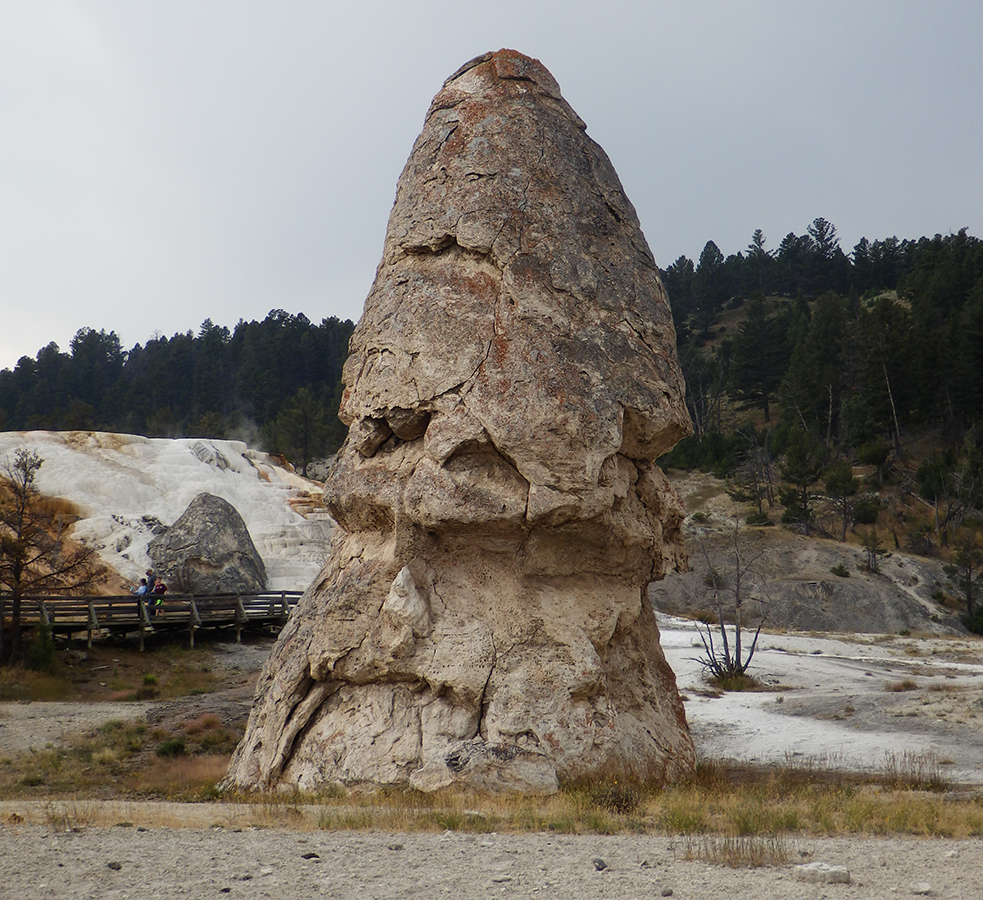
The hill above is also the result of mineral deposits which form intricate steps, each of which hosts different colored bacteria based on the water temperature and pH. This structure, and the bacteria living around it, is constantly changing. Photos in the visitor’s center show pools of green and blue. but during our visit the water was mostly clear, with the steps formed in rust and white. Though the boardwalks around it can get a bit crowded, it’s definitely worth the hike.
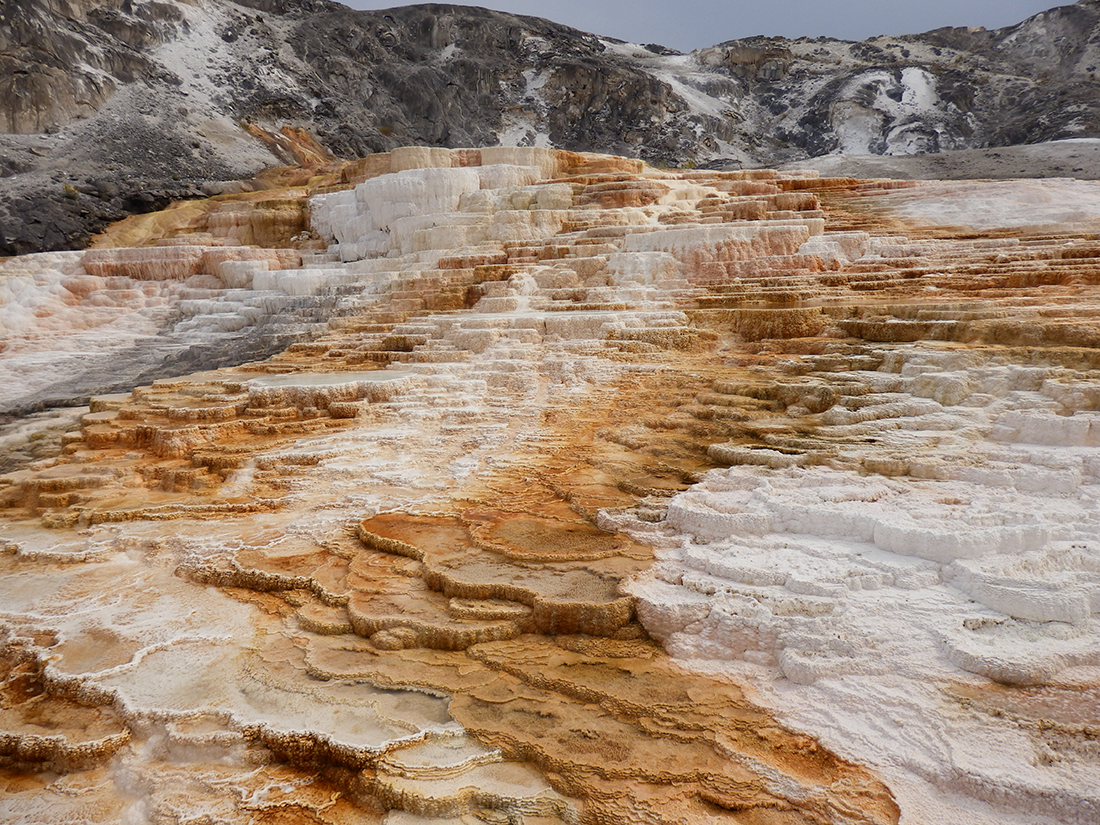
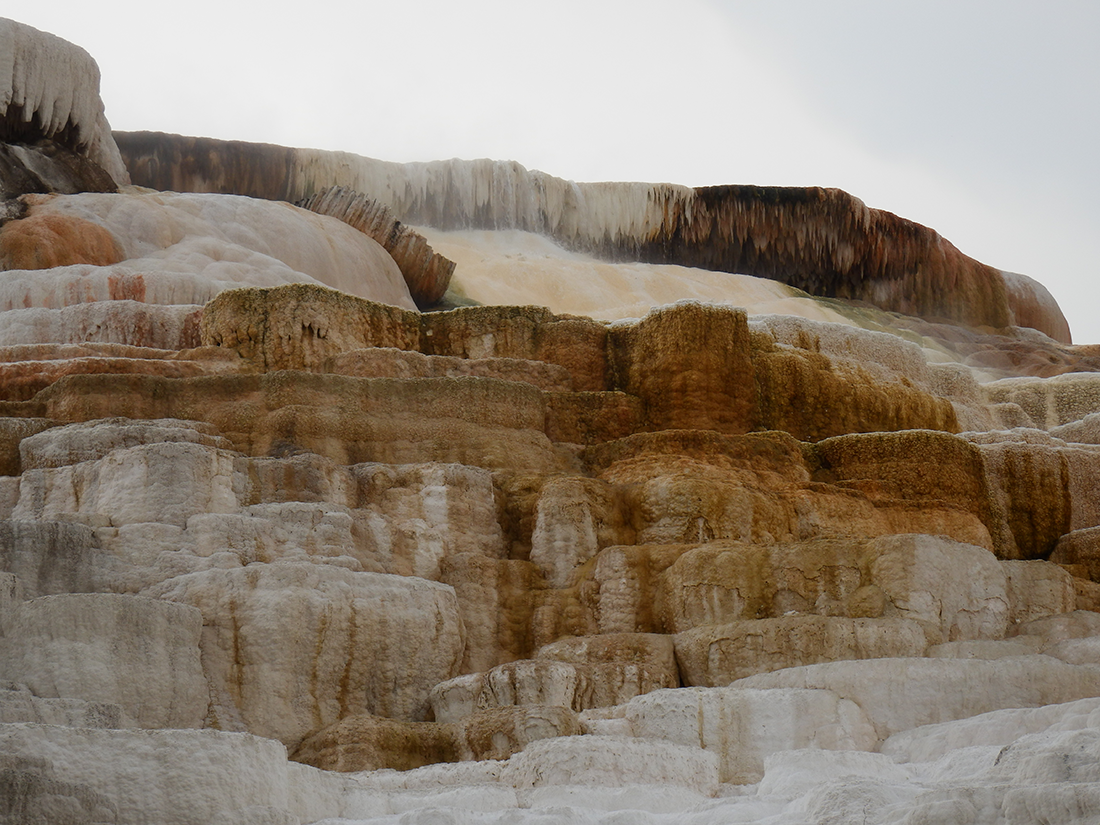
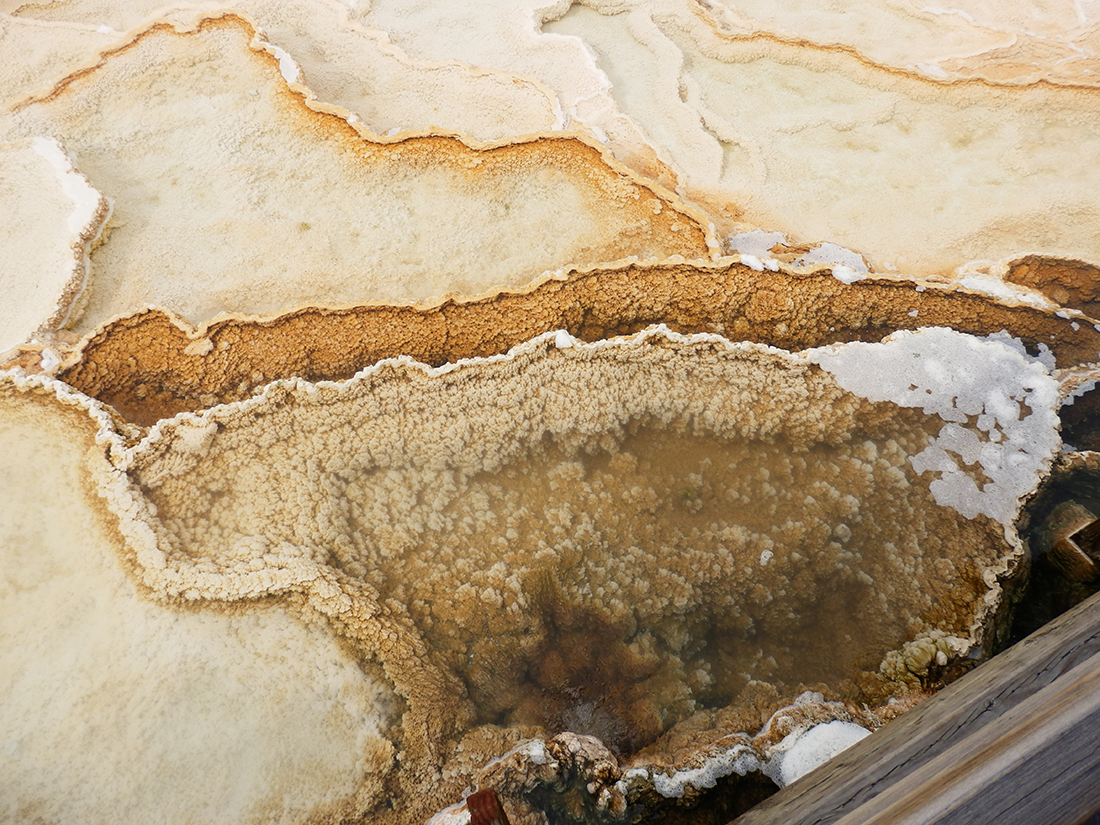
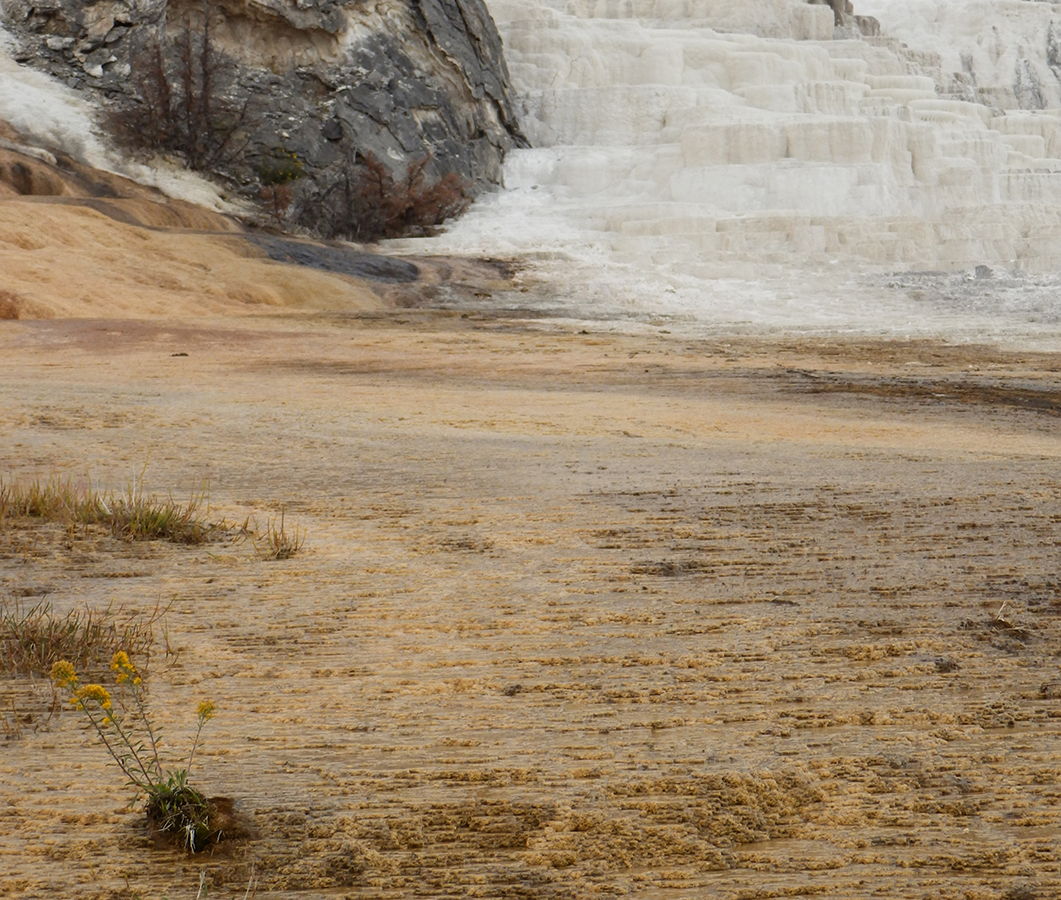
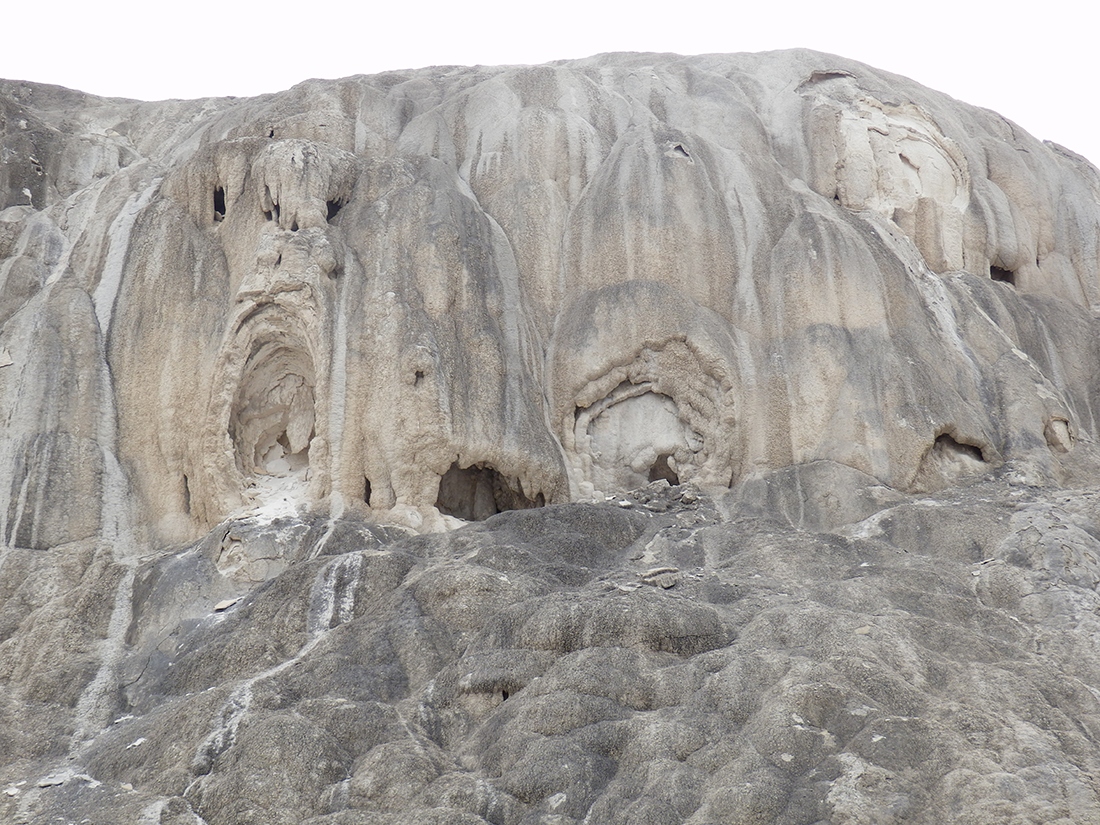
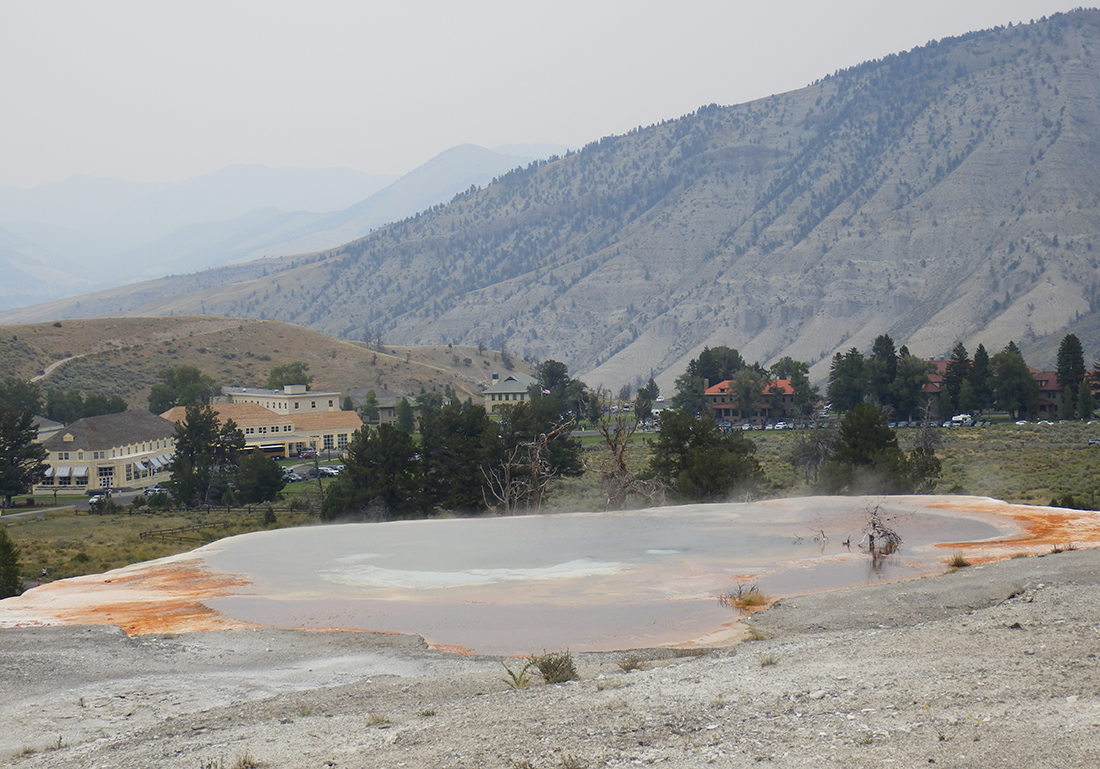
A boardwalk circles around the site, leading you over the most interesting spots and over the top of the hill. The top of the formation, shown above, is a bit of a letdown, as it’s just a gray plateau with a couple of steaming pools.
We turned south to Norris Geyser Basin, a swath of land containing the hottest, most acidic formations in the park. Acres of lunar wasteland spread out from in front of the small museum/visitor’s center with boardwalks leading from steaming cauldrons to spurting geysers. The boardwalks are there for good reason. Since 1870, the first recorded fatality in the park, 22 people have died in its thermal pools and geysers. Sometimes they can’t even recover a body before it is dissolved. What looks like a lovely swimming pool may be sulfuric acid. What appears to be a harmless puddle may suddenly explode with a column of steam hundreds of feet high. Even what appears to be solid ground my be a thin crust over a chasm full of toxic gas. What do you expect? It’s the floor of a #$%^&*ing super volcano!
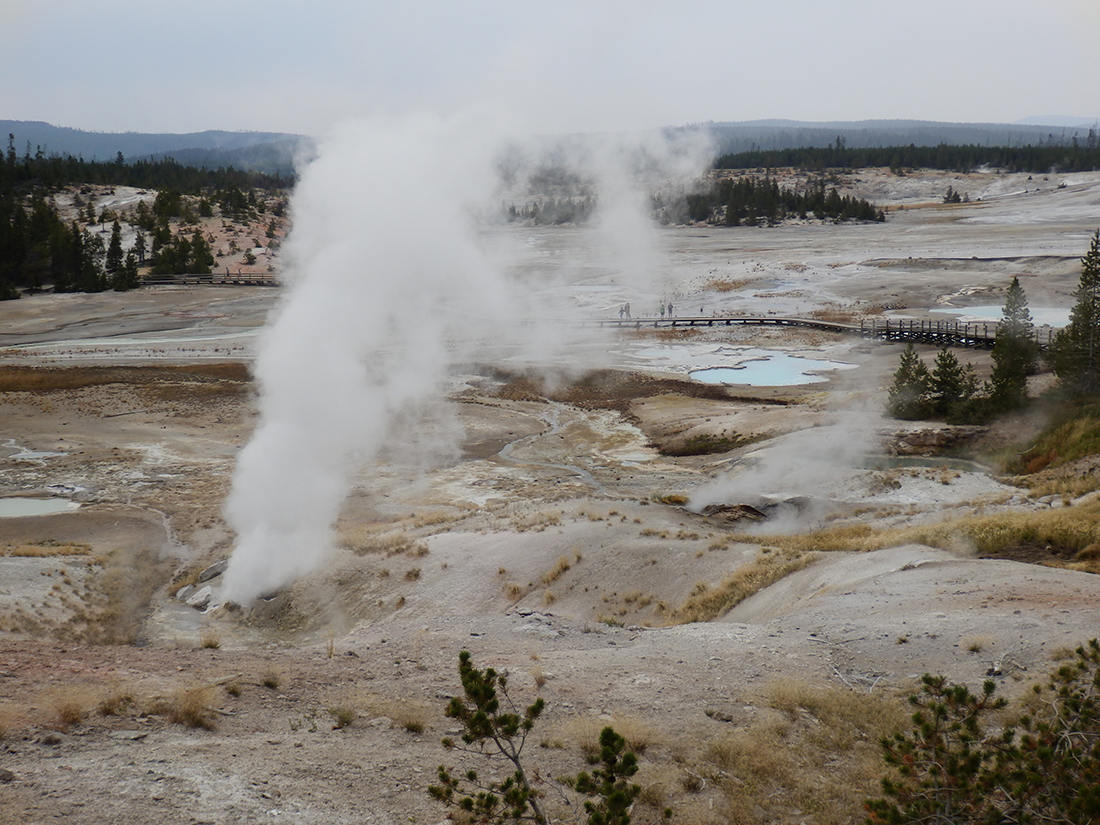
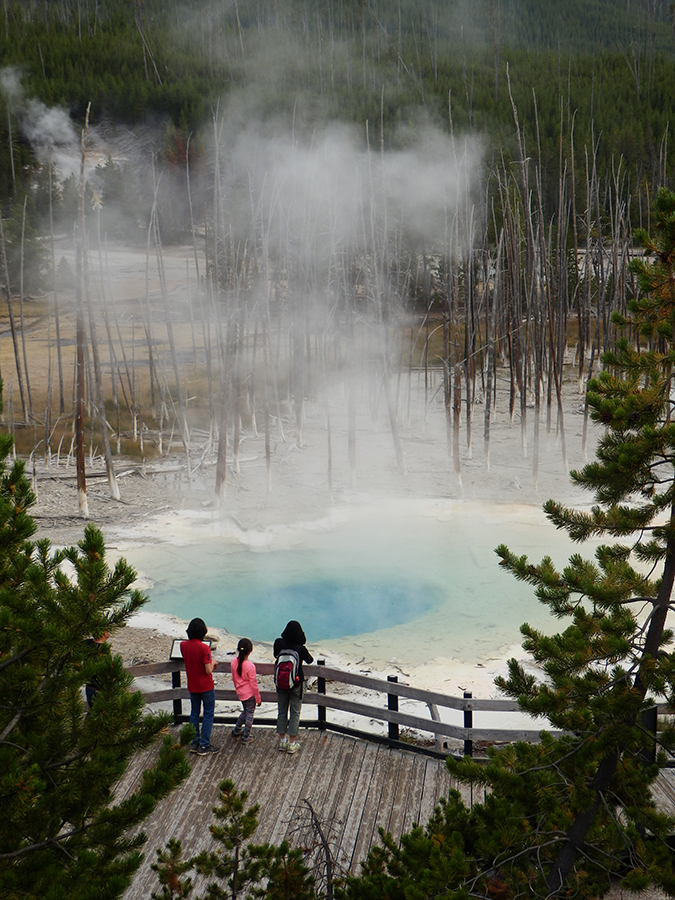
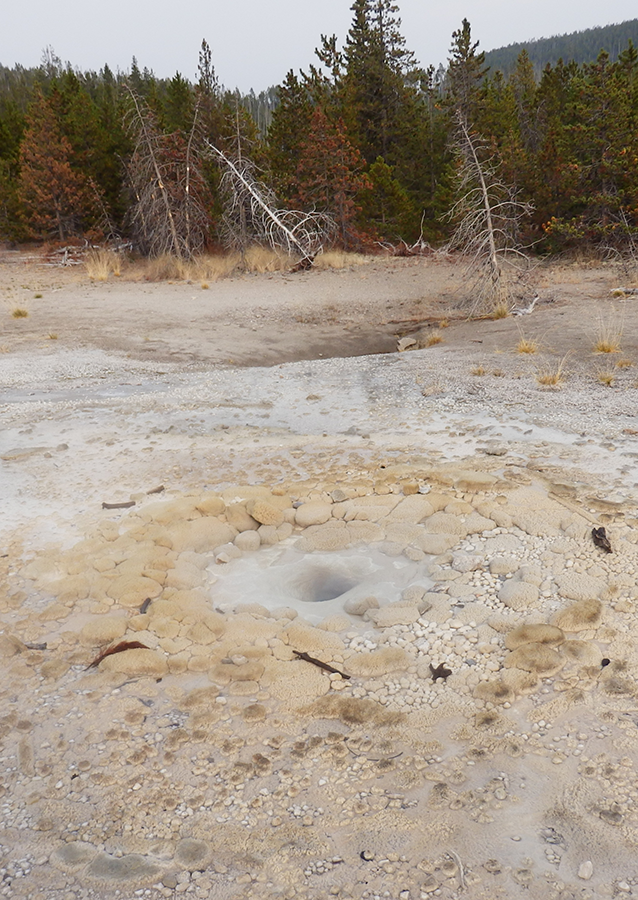
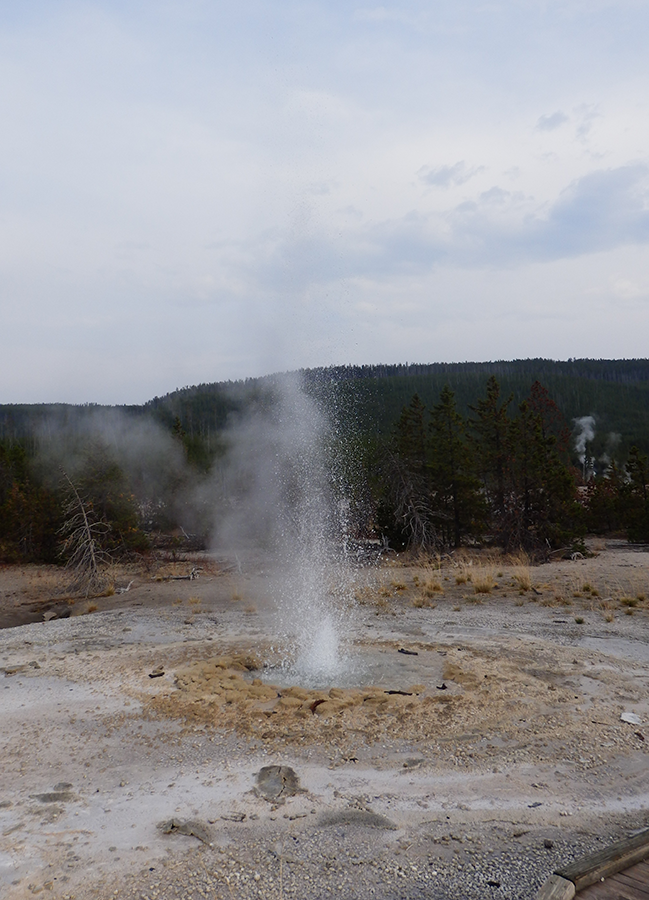
Yet there is life. There are lizards that survive here because of the warmth provided by the springs. Elk and bison leave tracks and droppings across the nearly barren plain. Trees invade, only to be boiled away by larger eruptions that come decades apart. There are mats of algae in the water that are the same as those from the dawn of life on earth.
Unfortunately, we hadn’t left enough time to see Norris Geyser Basin properly and had to speed back to the hotel for our dinner reservation. Local beer and bison burgers were the perfect end to a long, glorious day.
Grand Prismatic Spring was top of my brother’s Must See list, so we hit it early in the morning. We trekked across a bridge over the Firehole River as an osprey flew over, hunting fish in the clear stream.
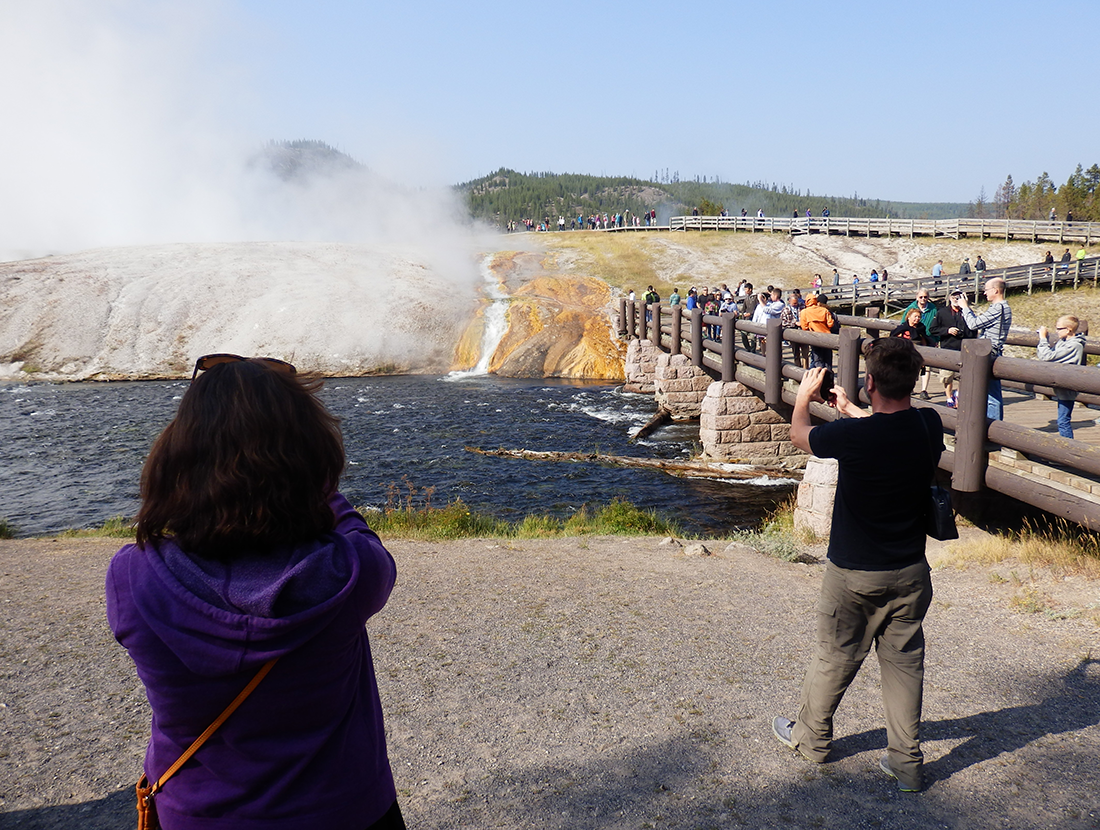
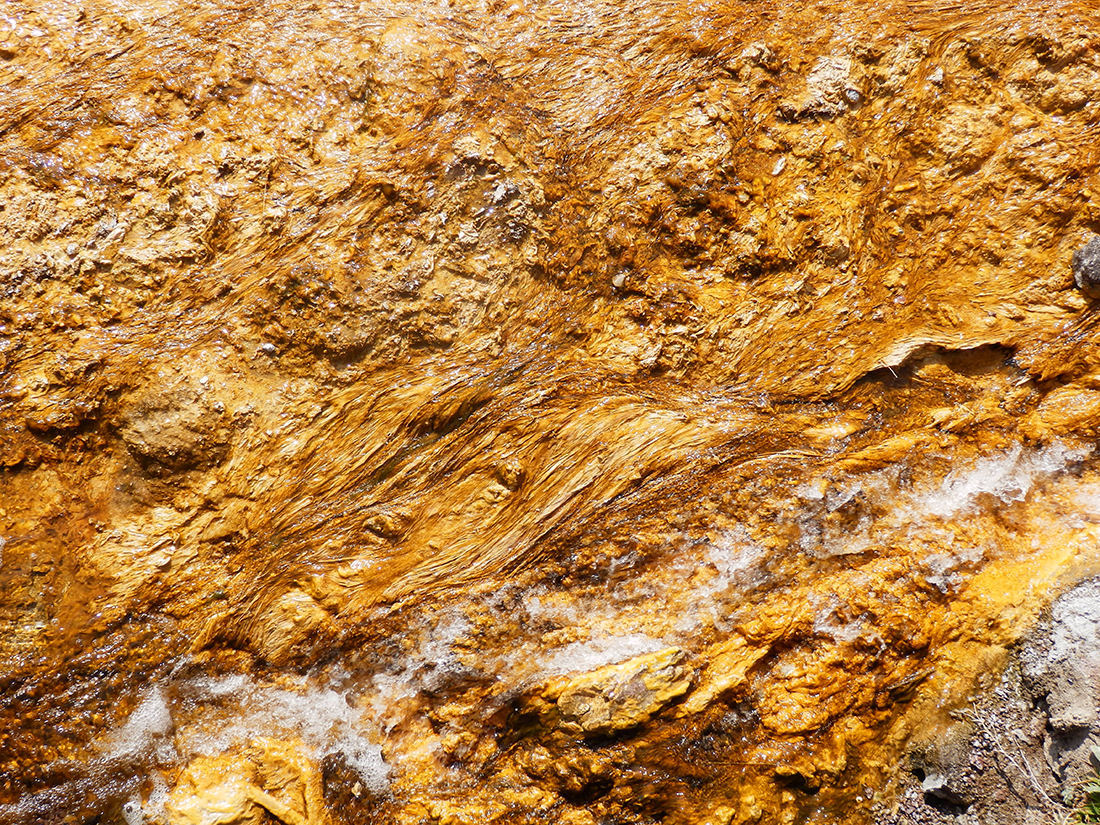
After passing another series of mineral formations and aquamarine pools, we got a look at the Grand Prismatic Spring (click, zoom, scroll.) Even the steam rising from the water forms different colors, pinks, blues and greens.
The pool itself is best viewed from above via a trail about half a mile down the road.
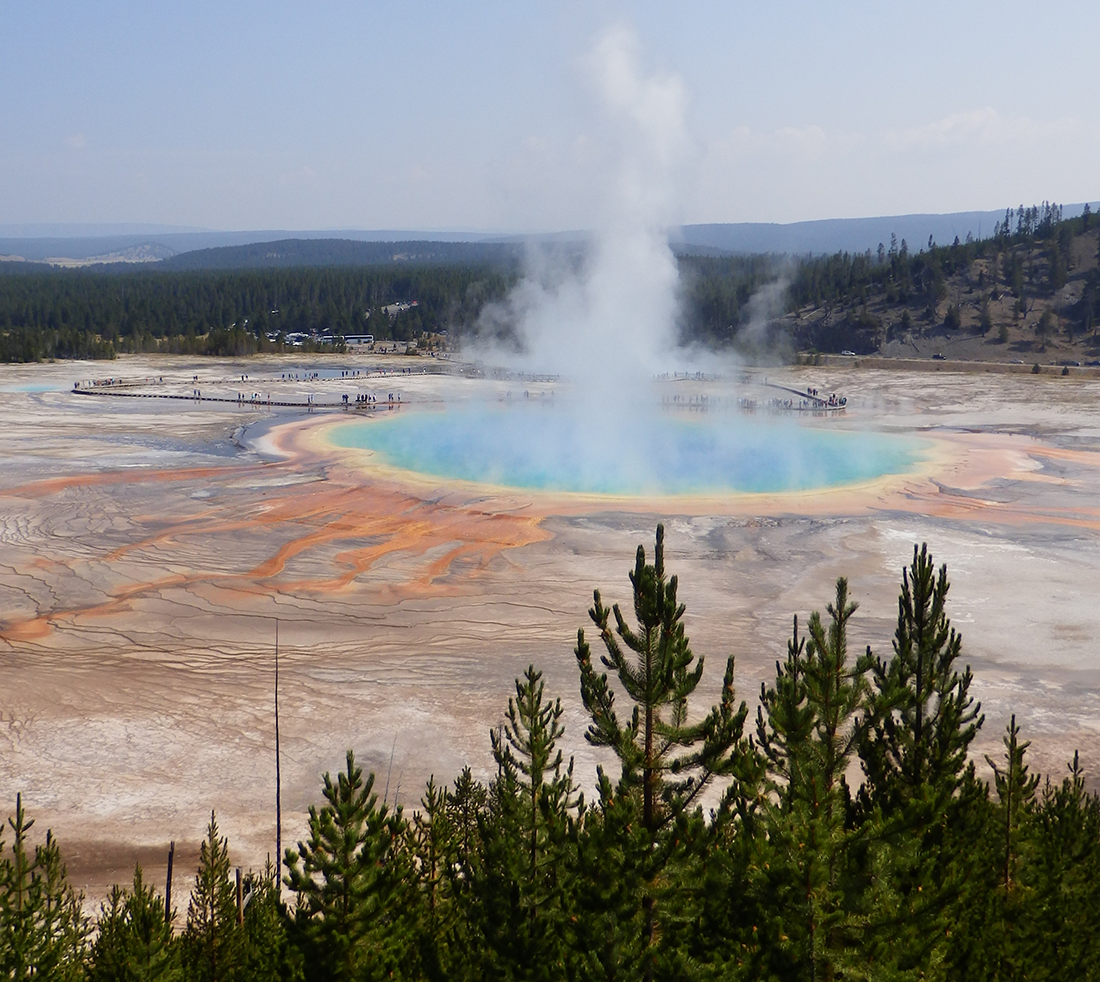
There are so many geothermal features in Yellowstone that some don’t even get a name – “just another deadly puddle,” I began to joke. This one is nestled between the parking lot for the overlook trail and the river. A sign nailed to a dead tree says, “Danger. Keep Out,” but the sign is small and I only noticed it when looking at photos when I got home. A row of logs around it may be a warning, but looks more like an inviting circle of seats.
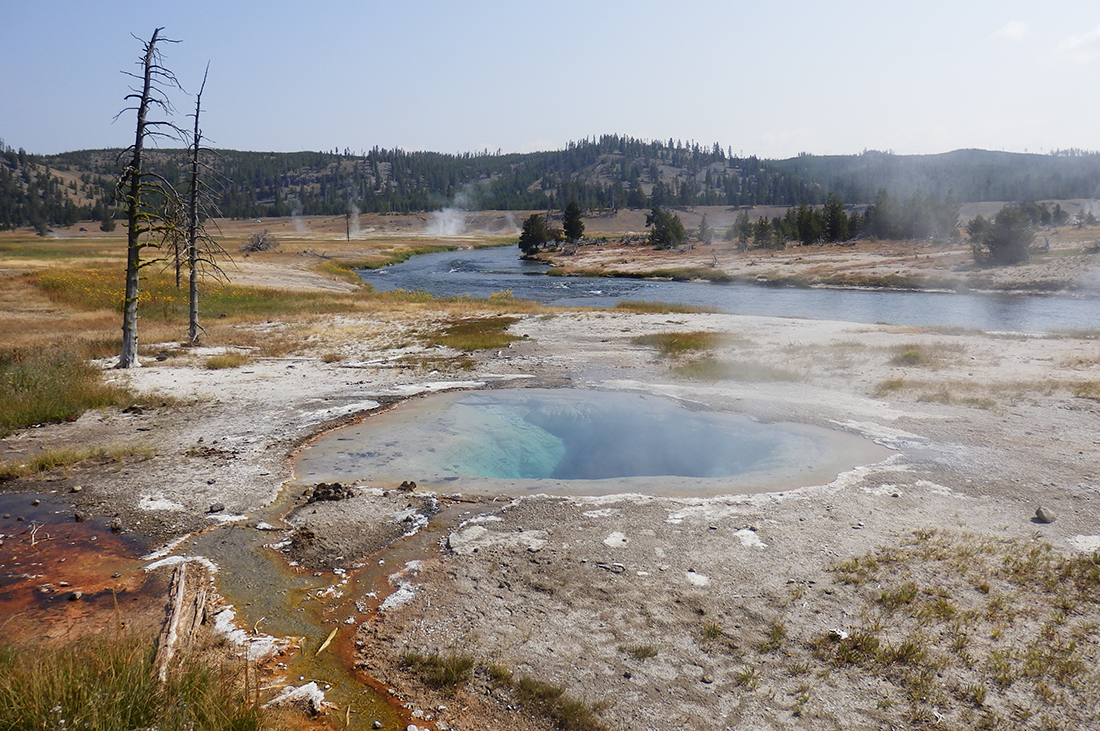
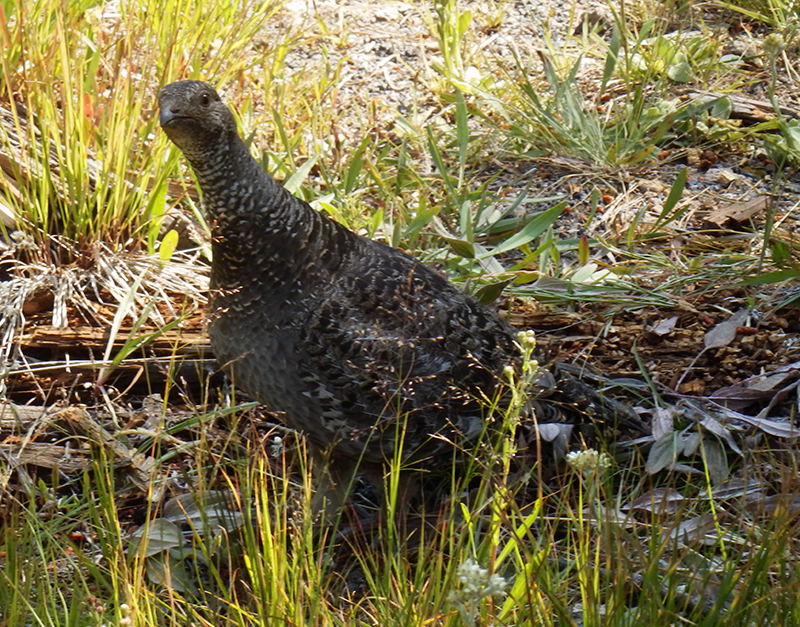
As if in contrast to the danger, a grouse walked across the path mere feet in front of us, escorting her babies up the hill.
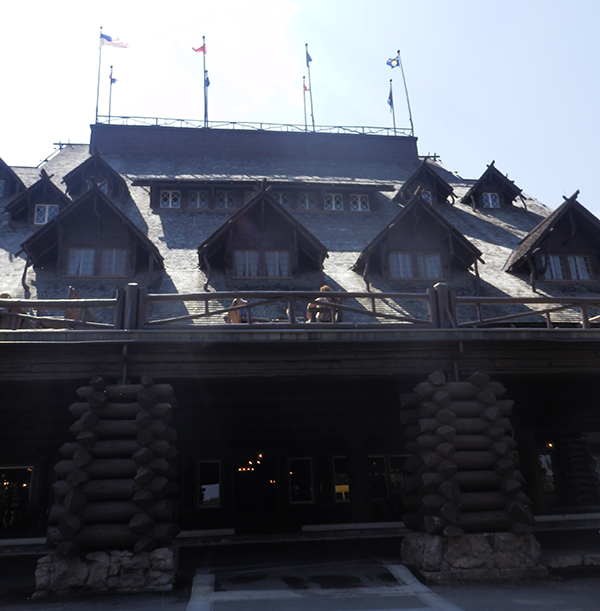 Old Faithful may be the most famous geyser in the world, but it is not largest or most regular even within Yellowstone. However, it is plenty big, regular within a few minutes, and surrounded by bleachers for easy viewing. (You might want to arrive earlier or later in the day to avoid the largest crowds.) We arrived to find we had an hour or so to kill so we wandered the lodge that is in itself is a Must See. I didn’t get a great shot of the exterior, due to back-lighting on the way in and forgetfulness on the way out, but it’s the lobby that will knock you out. It’s a cathedral in logs and stone.
Old Faithful may be the most famous geyser in the world, but it is not largest or most regular even within Yellowstone. However, it is plenty big, regular within a few minutes, and surrounded by bleachers for easy viewing. (You might want to arrive earlier or later in the day to avoid the largest crowds.) We arrived to find we had an hour or so to kill so we wandered the lodge that is in itself is a Must See. I didn’t get a great shot of the exterior, due to back-lighting on the way in and forgetfulness on the way out, but it’s the lobby that will knock you out. It’s a cathedral in logs and stone.
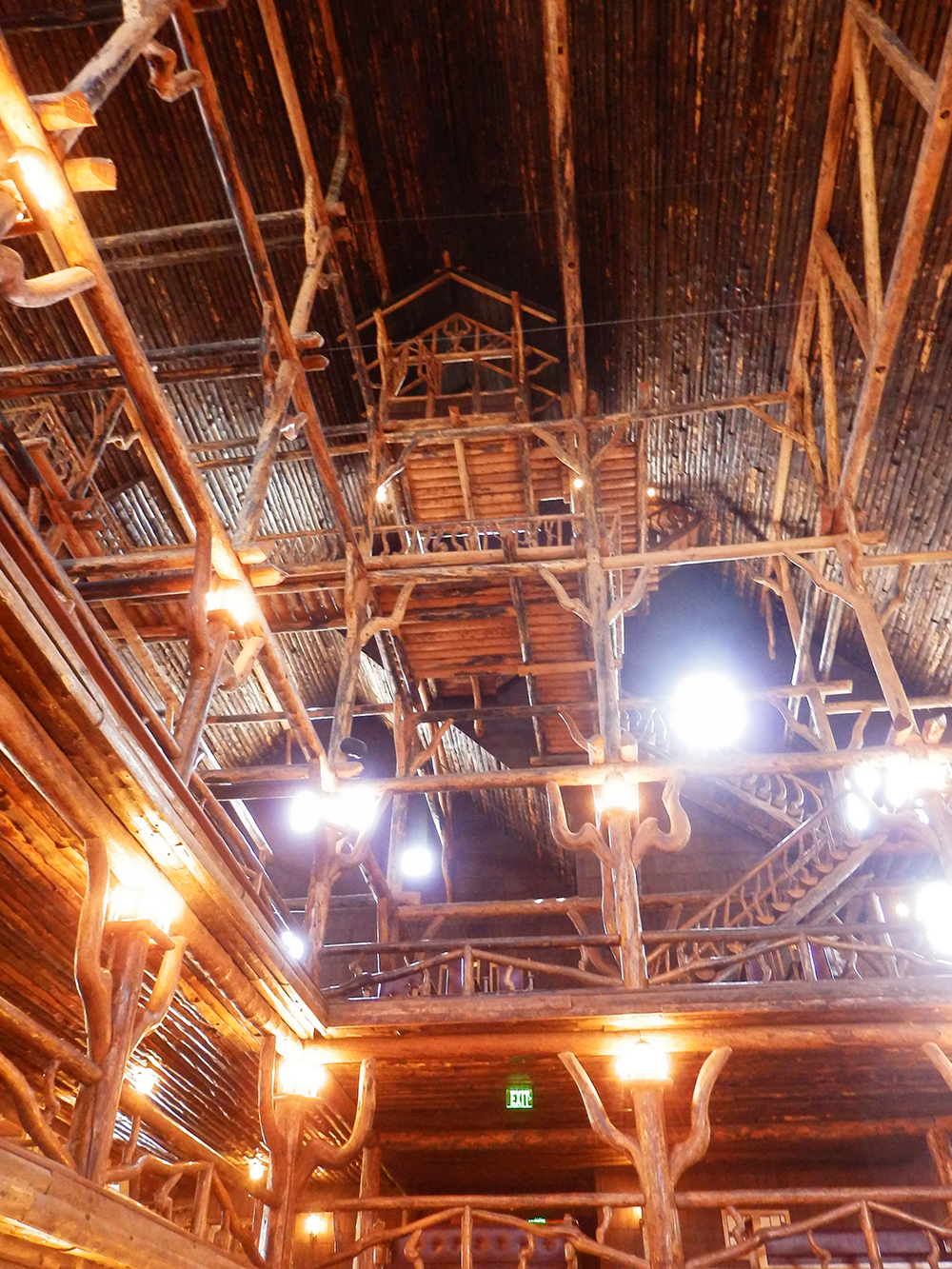
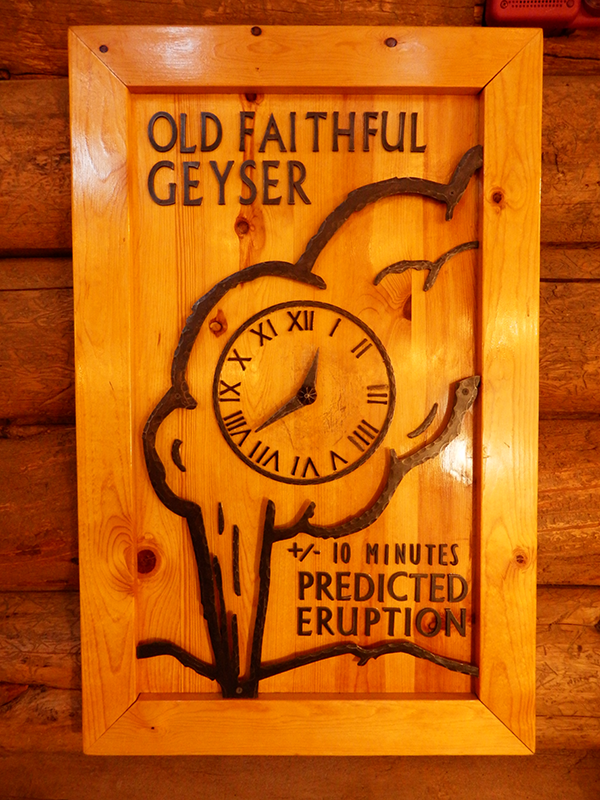
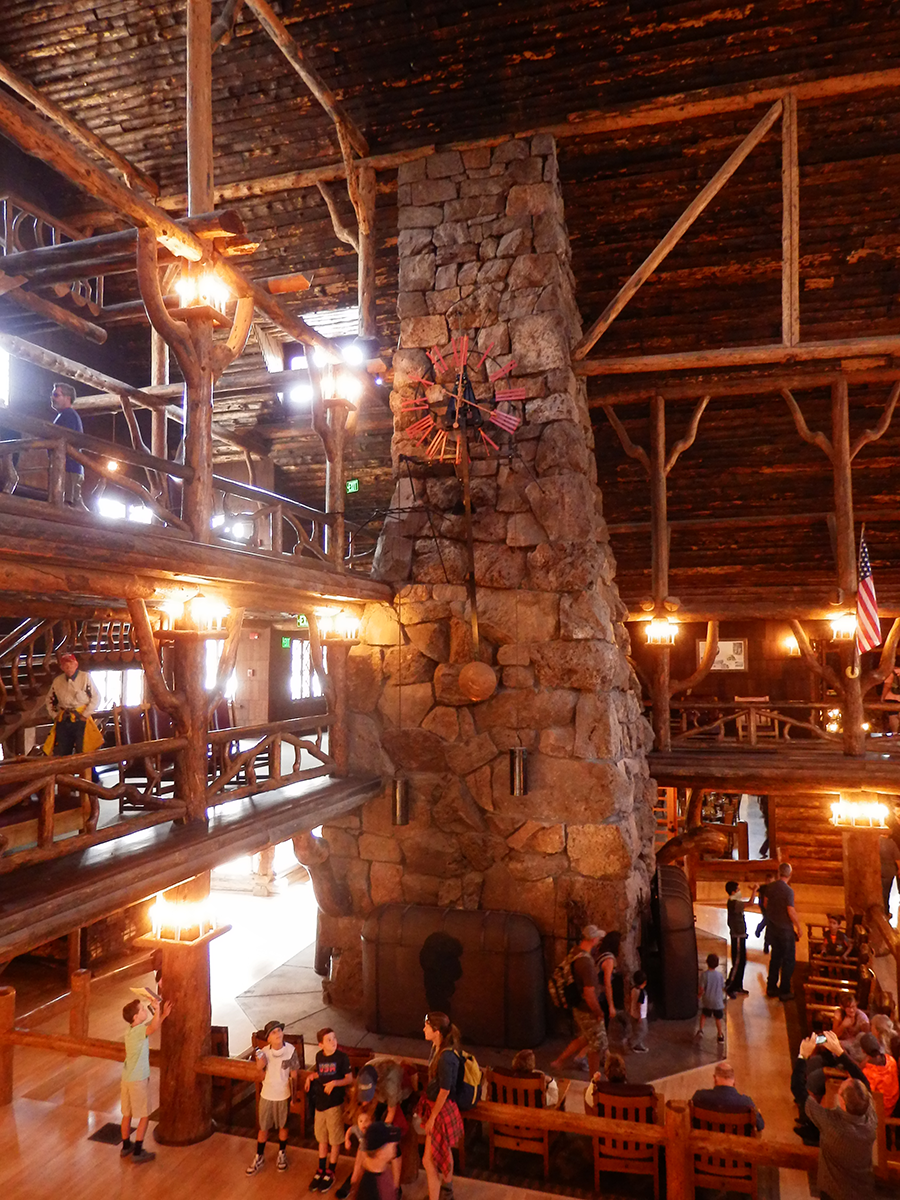
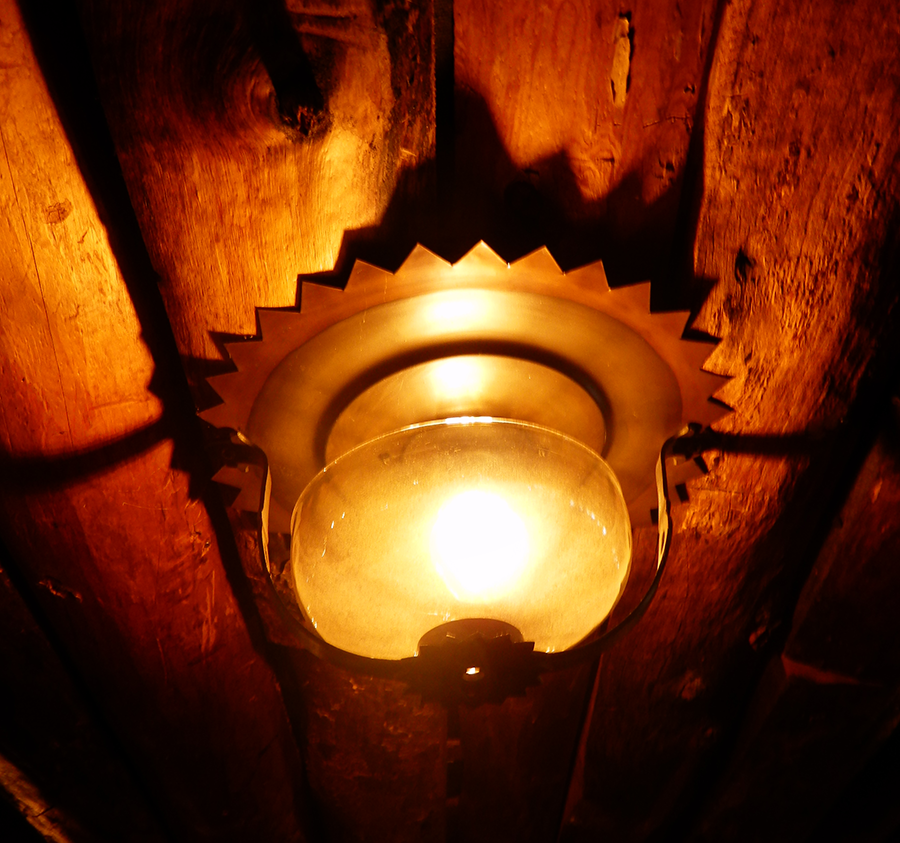
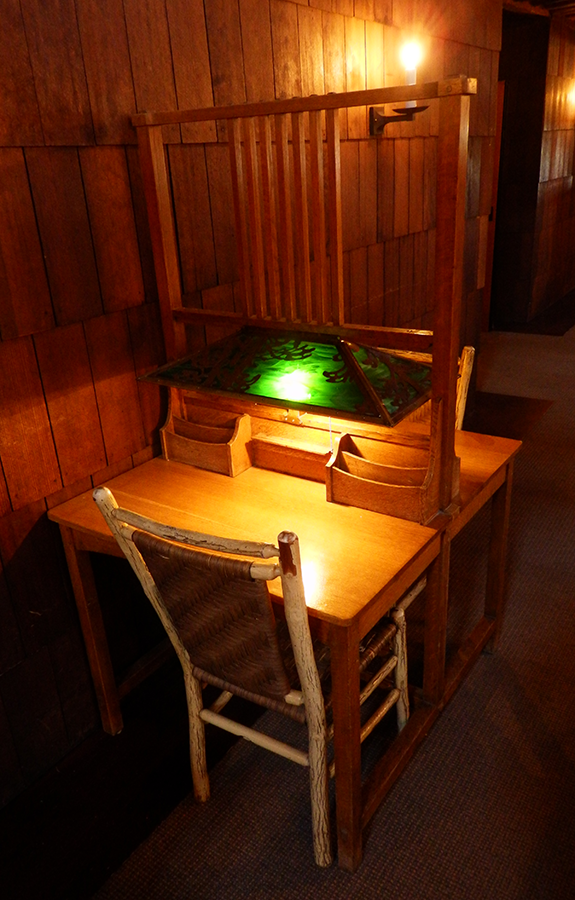
You can sit at one of the dozens of writing desks from back when people use to write – on paper! You can also get sandwiches and beers from the cafe just off the lobby and lounge in the sun or shade on the second story patio while Old Faithful erupts only a couple hundred yards away.
We opted for a closer look, however, joining the hundreds of people on the ring of bleachers. And then she erupted, looking just like the photos, posters, t-shirts, fridge magnets, beer labels and more that you’ve been seeing in every visitor’s center and general store in the park. Despite the hype, it’s pretty damn cool.
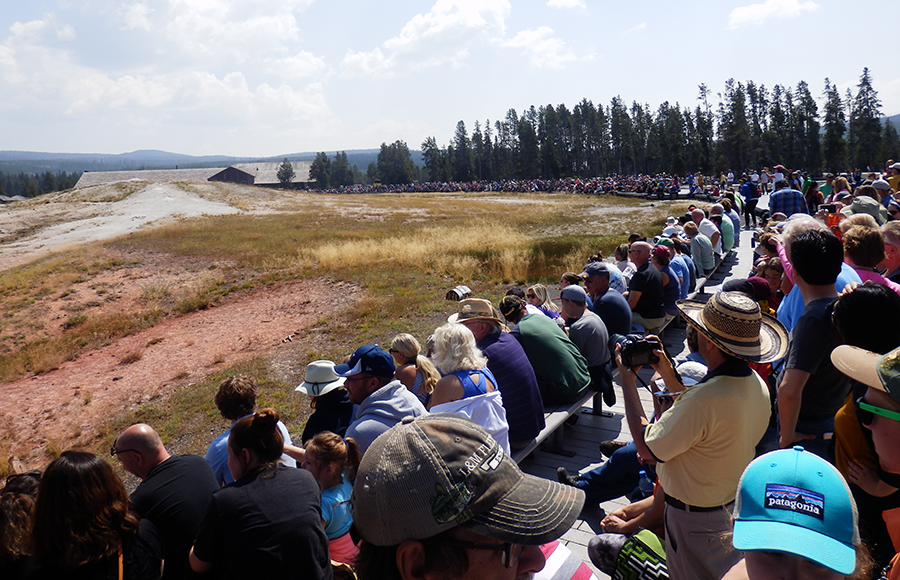
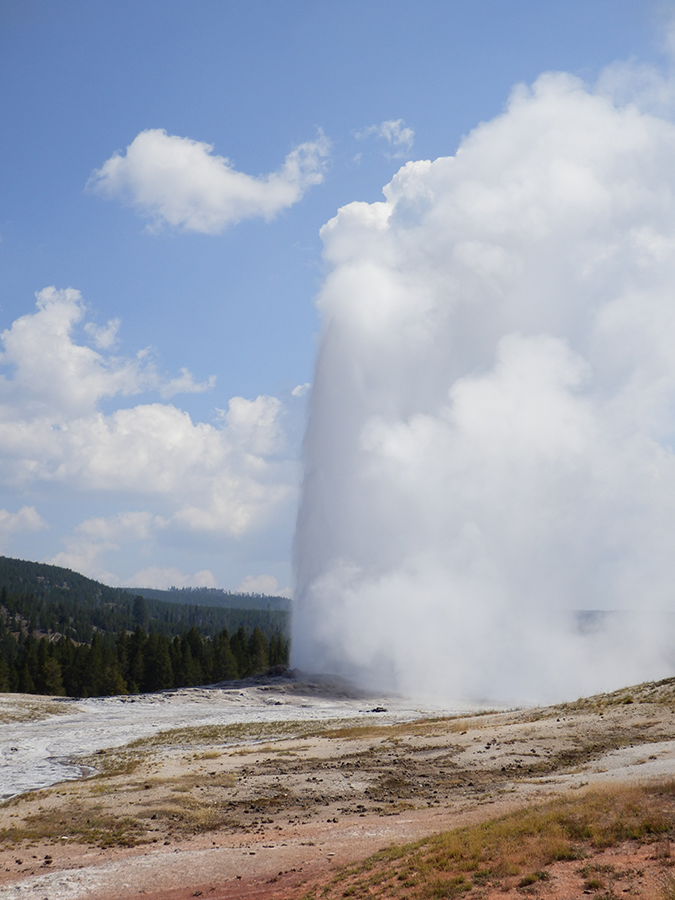
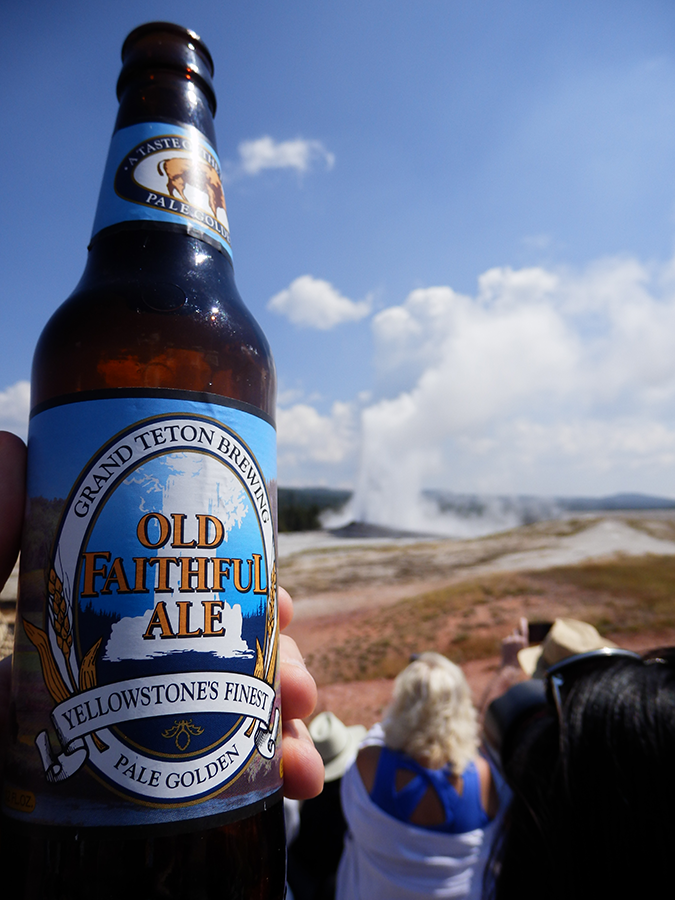
Our last stop was a swimming hole on Firehole River, one of the few places you’re allowed to get into water in the park – and one of the few places you’d actually want to where the water from hot springs mixes with the frigid river. Despite signs warning us not to, my brother and I leapt off a precipice into the crystal water. The temperature was perfect and, though the spot was crowded, I could’ve lounged in the water for hours. Unfortunately, we had miles to go to get back to Ennis, so we chased the setting sun out of the park. There’s never enough vacation time and money to do it all, of course. We missed a few thousand square miles of Yellowstone. Though we did it in a hurry, we hit most of the highlights in three days. If you asked my advice, I’d say give it four at a minimum, and take your time. Maybe you’ll see the bears and wolves we missed.